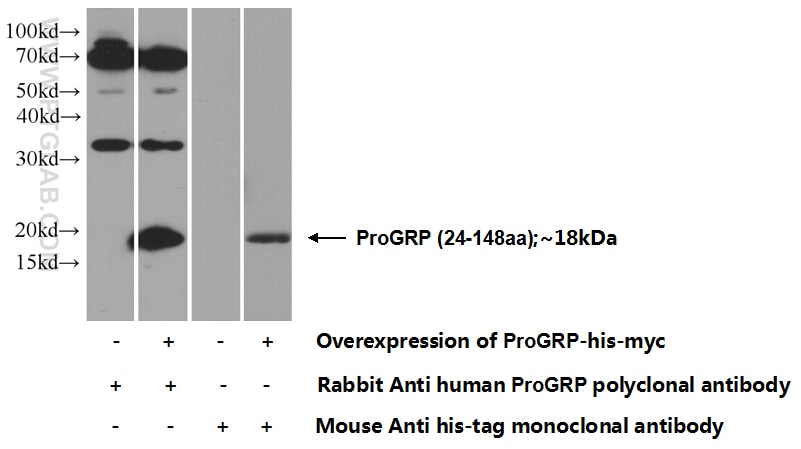Anticorps Polyclonal de lapin anti-ProGRP
ProGRP Polyclonal Antibody for ELISA
Hôte / Isotype
Lapin / IgG
Réactivité testée
Humain et plus (1)
Applications
IHC, ELISA
Conjugaison
Non conjugué
N° de cat : 14646-1-AP
Synonymes
Galerie de données de validation
Applications publiées
| IHC | See 1 publications below |
Informations sur le produit
14646-1-AP cible ProGRP dans les applications de IHC, ELISA et montre une réactivité avec des échantillons Humain
| Réactivité | Humain |
| Réactivité citée | Chimpanzé |
| Hôte / Isotype | Lapin / IgG |
| Clonalité | Polyclonal |
| Type | Anticorps |
| Immunogène | ProGRP Protéine recombinante Ag6239 |
| Nom complet | gastrin-releasing peptide |
| Masse moléculaire calculée | 16 kDa |
| Numéro d’acquisition GenBank | BC004488 |
| Symbole du gène | GRP |
| Identification du gène (NCBI) | 2922 |
| Conjugaison | Non conjugué |
| Forme | Liquide |
| Méthode de purification | Purification par affinité contre l'antigène |
| Tampon de stockage | PBS with 0.02% sodium azide and 50% glycerol |
| Conditions de stockage | Stocker à -20°C. Stable pendant un an après l'expédition. L'aliquotage n'est pas nécessaire pour le stockage à -20oC Les 20ul contiennent 0,1% de BSA. |
Informations générales
Gastrin-releasing peptide, also known as GRP, is normally formed by mucosal cells in the gastric antrum and by the D cells of the pancreatic islets, and its main function is to stimulate secretion of HCl by the gastric mucosa. HCl, in turn, inhibits gastrin formation. Its 148-amino acid preproprotein, following cleavage of a signal peptide, is further processed to produce either the 27-amino acid gastrin-releasing peptide or the 10-amino acid neuromedin C. These smaller peptides regulate numerous functions of the gastrointestinal and central nervous systems, including release of gastrointestinal hormones, smooth muscle cell contraction, and epithelial cell proliferation.These peptides are also likely to play a role in human cancers of the lung, colon, stomach, pancreas, breast, and prostate.


